#iyoba idia
Explore tagged Tumblr posts
Text

#blackisbeautiful#iyobaidia ring#iyoba idia#queen mother#benin#nigeria#africa#africanheritage#africanhistory#blackhistory#africanjewelry#afrocentrism#afrocentric#afrocentricart#afrocentricfashion#afrostyle#afropunk#afrohemian#afrohemianstyle#afrohemianaesthetic#blackpride#blackpower#problack#panafricanism#africandiaspora#blackness#rootingforeverybodyblack#blackpeople
188 notes
·
View notes
Text

Day 13: Idia!
Idia was born during the height of the Benin Empire, centered in modern-day Nigeria. She was a talented dancer, and caught the eye of Oba Ozulua, often known as Ozulua the Conqueror, who brought her into the palace as one of his wives.
She had Ozulua had at least one son together, Esigie, who was on paper third-in-line to the throne; in practice, succession tended to be a very contested matter. Idia’s political skills - as well as her reputation as a talented herbalist and potential sorceress - protected her son as one of his elder brothers sought to have him killed, and after Ozulua’s death, she helped Esigie take the throne.
Traditionally, the mother of the Oba was executed to prevent her exercising undue political influence; Esigie, however, was having none of it. He hid Idia until his coronation, after which he not only changed the law but instituted the position of Iyoba, or Queen Mother, making Idia one of his principal advisors. She was instrumental in his later political and military successes.
Esigie commissioned multiple artworks in honor of his mother, including four busts which survive today among the famous Benin Bronzes. Ritual scarring was common among the nobility, but according to legend, the parallel lines on Idia’s forehead had special meaning; her parents had incised them in attempt to ward off Oba Ozulua’s unwanted attentions, and they were later a locus for her magical and healing powers.
#idia#Nigerian history#Benin empire#history#awesome ladies of history#october 2023#my art#pen and ink#simpler drawings for these next few as I’m visiting my grandparents
7 notes
·
View notes
Text

Queen Mother Pendant Mask: Iyoba
This ivory pendant mask is one of a pair of nearly identical works; its counterpart is in the British Museum in London. Although images of women are rare in Benin's courtly tradition, these two works have come to symbolize the legacy of a dynasty that continues to the present day. The pendant mask is believed to have been produced in the early sixteenth century for the King or ObaEsigie, the king of Benin, to honor his mother, Idia. The oba may have worn it at rites commemorating his mother, although today such pendants are worn at annual ceremonies of spiritual renewal and purification.
2 notes
·
View notes
Photo

MWW Artwork of the Day (2/4/23) Kingdom of Benin (Nigeria) Memorial Head of a Queen Mother (Iyoba)(early 16th c.) Copper alloy statuette, 51 x 16 x 18 cm. Bode-Museum, Staatliche Museen zu Berlin
This is a commemorative bronze head from the medieval Kingdom of Benin in West Africa that probably represents Idia, mother of Oba Esigie, made during the early sixteenth century at the Benin court. The bronze head was made using the lost wax casting technique in the early sixteenth century. It is a very realistic representation of a young woman from the Benin court, who wears a high pointed ukpe-okhue crown of lattice-shaped red coral beads. The hairstyle is referred to as a "parrot's beak" hairstyle and was only allowed to be worn by the Iyoba and the major war chief. Queen Idia played an instrumental role in her son's successful military campaigns against neighboring tribes and factions. After her death, Oba Esigie ordered dedicatory heads of the queen to be made, to be placed in front of altars or in the Queen Mother's palace. The heads were designed to honor her military achievements and ceremonial power.
30 notes
·
View notes
Photo

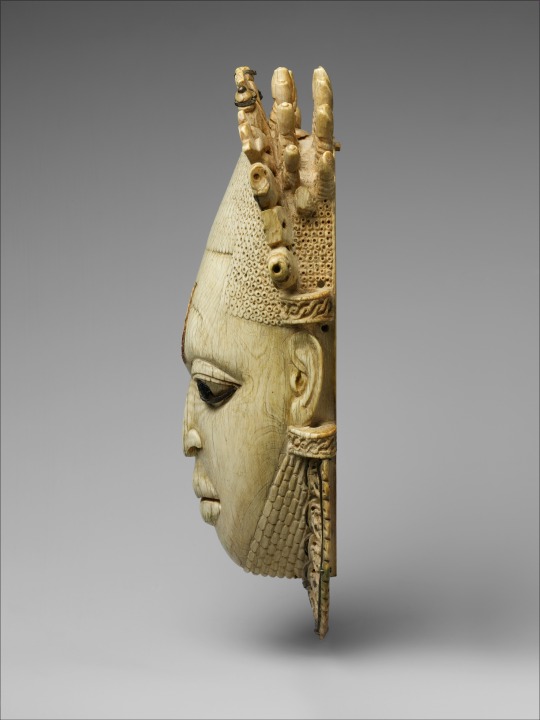
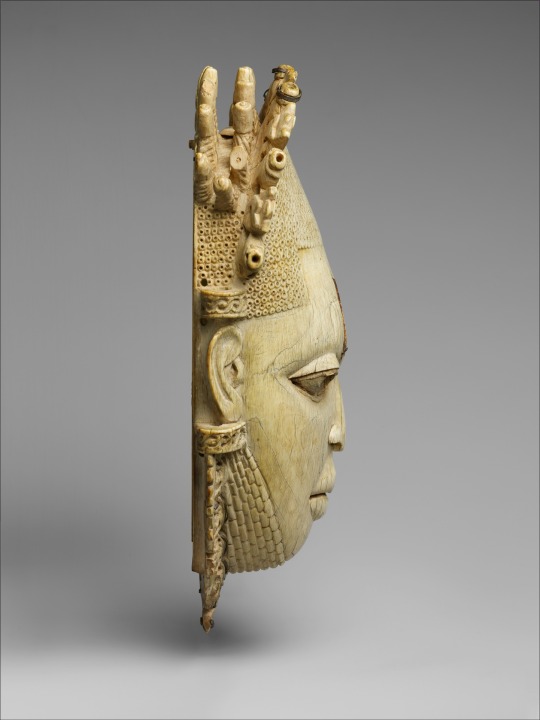
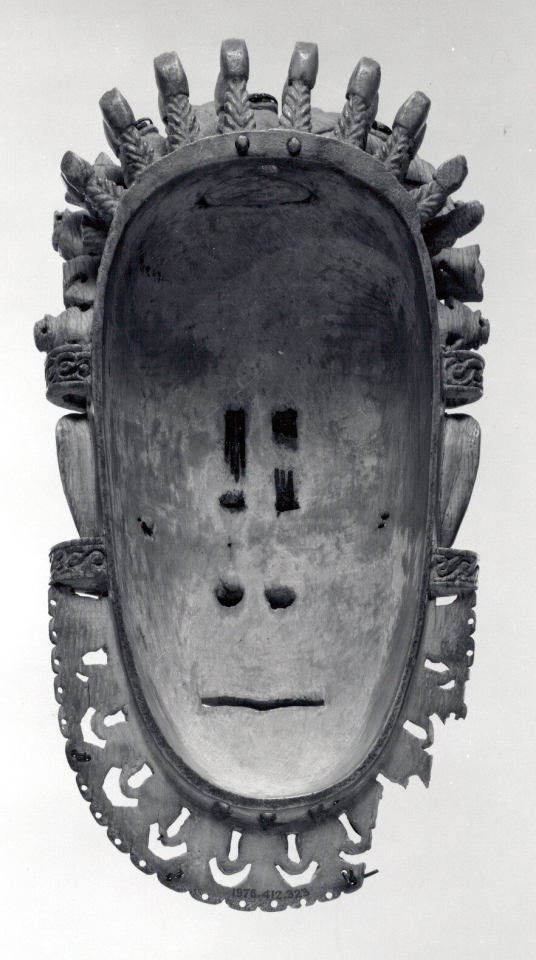
Queen Mother Pendant Mask: Iyoba, Benin, 16th century,
This ivory pendant mask is one of a pair of nearly identical works; its counterpart is in the British Museum in London. Although images of women are rare in Benin's courtly tradition, these two works have come to symbolize the legacy of a dynasty that continues to the present day. The pendant mask is believed to have been produced in the early sixteenth century for the King or ObaEsigie, the king of Benin, to honor his mother, Idia. The oba may have worn it at rites commemorating his mother, although today such pendants are worn at annual ceremonies of spiritual renewal and purification.
Ivory, iron, copper,
Dimensions: H. 9 3/8 x W. 5 x D. 2 1/2 in. (23.8 x 12.7 x 6.4 cm)
On view at The Met Fifth Avenue
#art#design#sculpture#mask#queen#mother#queen mother#iyoba#ivory#benin#idia#style#history#themet#iron#copper#edo art
38 notes
·
View notes
Photo
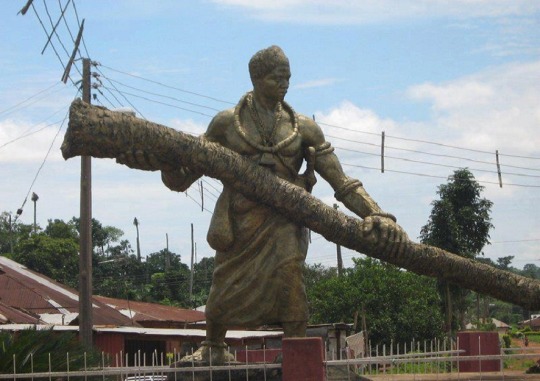
Idubor, the giant warrior prince of Benin who could uproot palm trees with his bare hands
Idubor came into this world at a time Great Benin was an important state that flourished in southern Nigeria. Also known as Arhuanran (sometimes spelled Aruanran), Idubor would have been the Oba (king) of Benin in the 1500s had his birthright not been taken away from him and given to his younger brother, Esigie, who was born on the same day he was.
According to history, Idubor’s mother gave birth to him a few hours before Esigie was born. However, because Idubor did not immediately cry at birth, Esigie, who did, was reported first to the king, Oba Ozolua, and his proclamation rights were performed. Idubor and Esigie had an older brother, Ogidigbo, who was the first son and thus next in line to the throne. But Ogidigbo broke his leg in a competition with his two brothers, and becoming cripple meant he had lost his right from taking over from his father.
As tradition demanded, Esigie, who was now the second child (after taking his brother, Idubor’s birthright) moved up to the first place, becoming the next in line to succeed his father to the throne. Locals accused Esigie’s mother, Idia, of being behind his brother Ogidigbo’s woes, claiming that she used mystical powers to improve her son’s chances of becoming the next Oba; this was not uncommon for royal wives to do at the time.
These and many other factors angered Idubor, and he would go to war with his brother on several occasions.
Their father, before his death, carved out dukedoms for both of them to avoid confusion — Idubor was made the Duke of Udo, a town not too far from Benin. But Idubor was not satisfied and continued to battle his brother, even making plans to assassinate him.
Idubor had then become a great warrior and conqueror and had grown up to be a giant. “Legend has it that he uprooted palm trees with his bare hands, sweeping the ground with the fronds. He turned out to be a great warrior who had the overwhelming advantage of size and stamina,” an account by Edo Historical Traditional Cultural Heritage says.
Another historical account states that Idubor “was bigger and stronger, and could easily have trounced the weaker Esigie, whom Oba Ozolua had sent to attend the Portuguese mission school after his baptism.”
Idubor could have therefore succeeded with his plans to kill his brother, Esigie had the latter’s mother, who was his spiritual protector, not intervened. Idia took on Idubor using mystical powers and his plans failed.
When Esigie later ascended the throne after the death of their father, many thought the power struggle between the two brothers would end. However, Idubor refused to concede defeat, and instead, he went back to Udo. There, with his army and his “newly acquired magical prowess” against Esigie, he began attacking the capital. An oral account states that Idubor even placed spells on the coronation beads of Esigie, driving him mad for days until he was cured.
The bitter war between Idubor and Esigie meanwhile continued in what became one of the bloodiest wars in Benin history. Idubor and his town Udo were eventually defeated in the battle and Idubor drowned himself in a lake – Lake Odighi N’Udo.
History says Esigie’s victory was during the planting season when many members of Idubor’s army, who were farmers, had gone to their farms.
Esigie would go on to reign over the ancient Benin Kingdom while maintaining a strong connection to Portugal throughout his reign. Becoming the first leader in the West-African Sub-Region to establish diplomatic relations with a European country, Esigie encouraged extensive trade with the Europeans though ensuring that his kingdom was independent of their control.
But the powerful Esigie has his mother to thank for his successful reign over Benin. His mother, Idia, became a strong influence on him as he “undertook nothing of importance without having sought her counsel.”
Esigie introduced a special post in the administration for his mother called the Iyoba, the Queen Mother, and commissioned a “highly improved metal art” that has since received wide acclaim. The famous Queen Mother Idia busts are some of the most well-known art pieces.
Idia’s image is also expressively captured in the famous Ivory mask, which served as the logo of the 2nd World Black and African Festival of Arts and Culture (FESTAC), held in 1977 in Lagos, Nigeria.
“The exquisite craftsmanship of the mask bears testimony to the quality of life and superlative level of civilization of the Benin people prior to their colonization,” an article by Trip Down Memory Lane said.
Years later, the British would invade the Benin kingdom and take away various works of art commissioned by Esigie, including Ivory and bronze works before burning down the ancient capital, Benin City. Today, most of these works of art are held in prominent museums, including the Metropolitan Museum of Art and the British Museum.
The Oba of the Benin Kingdom has, nevertheless, stood the test of time even though Nigeria’s history is made up of several unique elements.
While Nigeria is a constitutional democracy that elects its leaders, the hundreds of ethnic communities scattered across the country still acknowledge their own traditional rulers and among the most recognized traditional leaders in Nigeria is the Oba of Benin.
Enter email address to receive updates from Face2face Africa
#oba#benin#african#kemetic dreams#esigie#iyoba#west africa#lagos#idubor#european#idia#british#nigeria#benin city#trip down memory lane
43 notes
·
View notes
Photo

Queen Mother Pendant Mask: Iyoba, 16th century, an Ivory mask by the Edo peoples.
This mask belonged to the Oba Esigie, the king of Benin (what is now southern Nigeria) which was made to honour his mother, Idia. It is rare for women to have been represented in images of this culture, however Queen Idia was a monumental part of her son’s reign - and a fierce warrior herself. The Oba would have worn this during rites alluding to the significance of her.
The mask symbolises wealth, the importance of dynasties, and ritual purity. In this ivory portrait of Idia there are references to the Portuguese that came to trade during this time, scarification marks, and mudfish.
While there is a twin mask that resides in the British Museum in London, this one is in the collection of The Metropolitan Museum of Art.
#Queen Mother Pendant Mask: Iyoba#african mask#16th century#nigeria#edo people#Benin#Benin art#art history#1500's#ivory mask#ivory#sculpture#african art#africa#artwork#art history blog
654 notes
·
View notes
Text
Oba means ruler in the Yoruba and Bini languages of West Africa. Kings in Yorubaland, a region which is in the modern republics of Benin, Nigeria and Togo, make use of it as a pre-nominal honorific.
All of the subordinate members of the Yoruba aristocracy, both traditional titleholders and honorary ones, use the pre-nominal "Oloye" (lit. Owner of a title, also appearing as "Ijoye") in the way that kings and queens regnant use 'Oba'. It is also often used by princes and princesses in colloquial situations, though the title that is most often ascribed to them officially is "Omoba" (lit. Child of a Monarch, sometimes rendered alternatively as "Omo'ba", "Omooba" and "Omo-Oba"). The wives of kings, princes and chiefs of royal background usually make use of the title "Olori" (the equivalent of Princess Consort, otherwise spelled "Oloori"), though some of the wives of dynastic rulers prefer to be referred to as "Ayaba" (the equivalent of Queen Consort). The wives of the non-royal chiefs, when themselves titleholders in their own right, tend to use the honorific "Iyaloye" (lit. Lady who owns a title) in their capacities as married chieftesses.

Idia became the first Iyoba (Queen mother) of Benin when Esigie conferred upon her the title and the Eguae-Iyoba (Palace of the Queen Mother)
Queen Idia was the mother of Esigie, the Oba of Benin who ruled from 1504 to 1550. She played a very significant role in the rise and reign of her son. She has been described as a great warrior who fought relentlessly before and during her son's reign as the Oba (king) of the Edo people. When Oba Ozolua died, he left behind two powerful sons to dispute over who would become Oba. His son Esigie controlled Benin City while another son, Arhuaran, was based in the equally important city of Udo about 30 kilometres (20 mi) away. Idia mobilised an army around Esigie at Unuame on the River Osse, which defeated Arhuaran, and Oba Esigie became the 16th king (Egharevba, 1968:26).
106 notes
·
View notes
Photo

Getting set for day #2 of Afropunk London. The first day was pure bliss... Our latest release: the Iyoba Idia bronze ring. Come and say hi and find out more about this 'Hidden Oba' of the Benin Empire. Looking forward to seeing you all later.. #rings #accessories #bronze #jewelry #leader #afropunk #afropunklondon #blackfashion#london #londonfashion #africanfashion#africa #iyoba #idia #benin #blackhistory #africanhistory #history #market #naturalhair #africanbeauty #blackbeauty #edo #africanculture #africanroots#africa #tradition #blackhistory https://www.instagram.com/p/BW4xuhPB7Zf/?utm_source=ig_tumblr_share&igshid=vlwac4lfpkod
#2#rings#accessories#bronze#jewelry#leader#afropunk#afropunklondon#blackfashion#london#londonfashion#africanfashion#africa#iyoba#idia#benin#blackhistory#africanhistory#history#market#naturalhair#africanbeauty#blackbeauty#edo#africanculture#africanroots#tradition
0 notes
Photo



Women Leaders in African History: Idia, First Queen Mother of Benin
Queen Mother Pendant Mask: Iyoba. 16th century Nigeria, Court of Benin
Head of a Queen Mother (Iyoba). Nigeria, Court of Benin, Edo peoples, 1750–1800.
Altar Tableau: Queen Mother and Attendants. 18th century Nigeria, Court of Benin
0 notes
Photo

LEGEND OF YASUKE! “Osayuki was born around the time of King Esigie and Queen Iyoba Idia. His captors thought changing his name to Yasuke would make him forget his roots. They were wrong....” LEAD ARTIST: Dominic Omoarukhe INKS: Kazeem Oladejo Release Date: Oct 1st 2019 TAG Comics #tagcomics #legendofyasuke #osayuki #nigeriancomics #africancomics https://www.instagram.com/p/B1oxmzeg1jw/?igshid=djnh5578adm9
0 notes
Text
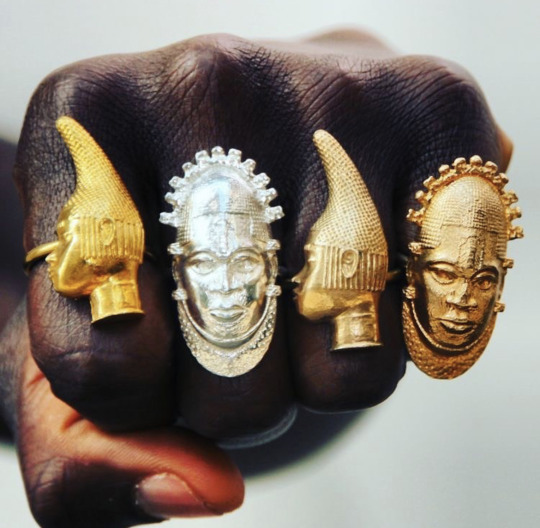
#blackisbeautiful#Aṣọ#@asoglobal#iyobaidia ring#iyoba idia#queen mother#benin#nigeria#africa#africanheritage#africanhistory#blackhistory#africanjewelry#afrocentrism#afrocentric#afrocentricart#afrocentricfashion#afrostyle#afropunk#afrohemian#afrohemianstyle#afrohemianaesthetic#blackpride#blackpower#problack#panafricanism#africandiaspora#blackness#rootingforeverybodyblack#blackpeople
463 notes
·
View notes
Photo

#NewTshirtAlert I recently discovered the story of the Iyoba, which translates to Queen Mother of the King. It's an actual title in the kingdom where the mother of the king is given political power and other privileges that's normally only given to the king. This particular image is a sculpture from the Benin Kingdom, which is modern day Nigeria. The first Iyoba was Queen Mother Idia who fought to establish and maintain the kingdom for her son Oba Esigie against his brother who also was up to inherit the throne. The more I read it the more it sounded like the storyline used in the Marvel Black Panther movie between T'challa and Killmonger. I'm almost certain this story inspired the movie in some way. Anyway...I think it's a strong image and a powerful story. The perfect example of a mother literally going to battle for her son to protect him and his future. #Iyoba #AfricanHistory #BeninKingdom #BlackHistory #AfricanArt #BlackMothers #TellBlackStories #BlackPanther #Tchalla #Killmonger #Etsy #Linkinbio https://www.instagram.com/p/Bw19Ky1gixk/?utm_source=ig_tumblr_share&igshid=1006i224wv9t0
#newtshirtalert#iyoba#africanhistory#beninkingdom#blackhistory#africanart#blackmothers#tellblackstories#blackpanther#tchalla#killmonger#etsy#linkinbio
0 notes
Photo

Queen Mother Pendant Mask: Iyoba / Idia , early 16th century, traditional African mask / pendant / emblem
0 notes
Photo

✨🌬🔥The ancestors are my backbone🌬🔥✨ ••••••••• 👑 queen mother, Iyoba Idia, of the Benin/ Nigerian empire. This was; birth place of Yoruba Culture. The @africanancestry test I took said that my family was of the Tikar tribe of Cameroon. In the late 1400s, Portuguese exploration, colonization, and pillaging came to the shore of the Ivory Coast. While many countries unaware of the onslaught that would be the transatlantic slave trade was just beginning to show its seed of depravity in the rich black soil, Idia didn't send Ivory or slaves to the Europeans, she sent her ONLY SON. Unfortunately, while Southern tribes like the Tikar were being captured, Idia saw a way out through Magic, Knowledge, and straight up BADASSERY🙌🏾 She saw that the Portuguese would take and take so she SENT HIM THERE, leading in battle and her court FEROCIOUSLY so her son could take the opportunity to rise above the ranks of the leaders prior to him; he was recovering knowledge from all corners of the world, learning the tricks and trade of the people who'd eventually try to push North from Cameroon into Nigerian territory to enslave free cultured people. While her son was aboard learning the ways of the world, Iyoba Idia was a WARRIOR QUEEN. She sure up their borders, protecting her people establishing the city of Bini, now Benin. Of course, as we know, slavery overtook the ivory coast once the more countries arrived, mainly the Brits and Dutch. With them, they brought strife and stripped us of our cultural identity, our heritage, our land, birthrights, and names but today we can learn from the past. This is just ONE part of Idia’s story; her life was a mystically technicolored tapestry and because of women like her I know that I HAVE TO and CAN go above and beyond my own dreams or expectations. Her spirit, her story has moved me since I was a child. Her face is a reflection of my own. Her Ori is one with mine. #iyobaidia https://www.instagram.com/p/BtxXswPF-Sc/?utm_source=ig_tumblr_share&igshid=88oalefneniy
0 notes
Photo

Yesterday at Relé's #YoungContemporaries 2019 exhibition. I had the opportunity to lend my ears and eye (camera) to Friends, Acquaintances, and 'Contemporaries'. Osaze, Stephen and Fidelis in particular. @stephen.tayo's fashion portraits, unfortunately not pictured here, employs his consistent gaze on the duality of a subject or subjects, wherein for this exhibition he titles "Ìbejì". @painterabe also placed an interesting installation [no 5] of playful and lolly 'popish' remark as his minimalist an pop paintings. @fidex39 pulls an almost bizarre, jaw gnashing stories of the "Salkur" a slowly eroding practice in his hometown in Adamawa State. Attempting to link the abstraction with the spiritual tradition of personal fortification. While Osaze, who has been secretly archiving and studying Benin culture under the Instagram account @ezvso strays slightly from his at times satirical depiction of Benin culture. This time, he re-tells the story of the Benin kingdom during the 14th century. While he played with and drew comparisons with the Christian iconography, in the baptism of Ọba Esigie of Benin [no 1] by the Portuguese missionaries, & above him the perpendicularly aligned bird of prophecy, reminiscent of Jesus' baptism. In particular for me is the fairly noticeable change in horizon across the four panels, (only three panels are pictured above) where the Ọba & the Queen Mother Iyoba Idia - first submerged in water, [below eye level] - Ascends to war in the shape of the leopard [this at eye level] - kills the bird of prophecy [frog eye view (low perspective)] - and ascends to heaven with her own 'twelve' Court maidens. [Above eye level]. Osaze even pays attention to the semi-naturalistic representation of the Benin bronze sculptures. The wide eyes, & nose, etc. One could even draw parallels in modern context to feminism, where Ọba Esigie (the son) is placed below and at eye level, while his mother Iyoba Idia is placed at an angle depicting imposing strength as she kills the bed of prophecy, and above eye level where she is lofted into the skies... But I'd leave at that. The exhibition is still open for viewing @relegallery Do check it out. #art (at Lagos, Nigeria) https://www.instagram.com/p/Bsohon7FVrz/?utm_source=ig_tumblr_share&igshid=1uhraj0rxf5r
0 notes